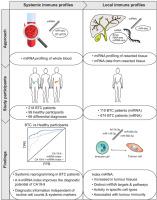Journal of Hepatology ( IF 26.8 ) Pub Date : 2022-06-21 , DOI: 10.1016/j.jhep.2022.05.036 Dan Høgdall 1 , Colm J O'Rourke 2 , Finn O Larsen 3 , Shahryar Zarforoushan 4 , Troels D Christensen 3 , Awaisa Ghazal 2 , Mogens K Boisen 3 , Patricia Muñoz-Garrido 2 , Julia S Johansen 5 , Jesper B Andersen 2

|
Background & Aims
Late diagnosis is a critical factor undermining clinical management of patients with biliary tract cancer (BTC). While biliary tumours display extensive inter-patient heterogeneity, the host immune response may be comparatively homogenous, providing diagnostic opportunities. Herein, we investigated whether cancer-associated systemic reprogramming could be detected non-invasively to improve diagnosis of BTC.
Methods
In this prospective Danish study, whole blood (WB) microRNA (miRNA) profiling was performed in samples from 218 patients with BTC, 99 healthy participants, and 69 patients with differential diagnoses split into discovery (small RNA-sequencing) and validation (RT-qPCR) cohorts. miRNA expression and activity were further investigated in 119 and 660 BTC tissues, respectively.
Results
Four WB miRNAs (let-7a-3p, miR-92b-5p, miR-145-3p, miR-582-3p) were identified and validated as diagnostic of BTC on univariable analysis. Two diagnostic miRNA indexes were subsequently identified that were elevated in patients with BTC and in patients with differential diagnoses, compared to healthy participants. The combination of these miRNA indexes with serum CA 19-9 significantly improved the diagnostic performance of CA 19-9 alone, consistently achieving superior AUC values irrespective of clinical setting (minimum AUC >0.84) or tumour location (minimum AUC >0.87). The diagnostic information captured by miRNA indexes was not recapitulated by routine clinical measurements. Index miRNA expression in BTC tissues was associated with distinct pathobiological and immune features.
Conclusions
WB miRNA profiles are altered in patients with BTC. Quantification of miRNA indexes in combination with serum CA 19-9 has the potential to improve early diagnosis of BTC, pending further validation.
Lay summary
Surgery is currently the only curative intervention for patients with biliary tract cancer (BTC). However, resection is not possible for most patients who are diagnosed with late-stage disease. With the aim of identifying new early diagnostic opportunities, we analysed circulating microRNAs (small non-coding RNAs whose role in cancer is being increasingly recognised) in whole blood samples. We identified a microRNA signature that could distinguish patients with BTC from healthy participants. These miRNAs significantly improved the diagnostic potential of the routinely measured biomarker, CA 19-9, and were implicated in distinct immune processes in tumour tissues.
中文翻译:

全血 microRNA 捕获系统性重编程并在胆道癌患者中具有诊断潜力
背景与目标
晚期诊断是影响胆道癌 (BTC) 患者临床管理的关键因素。虽然胆道肿瘤表现出广泛的患者间异质性,但宿主免疫反应可能相对同质,提供了诊断机会。在此,我们研究了是否可以无创检测癌症相关的系统性重编程以改善 BTC 的诊断。
方法
在这项丹麦前瞻性研究中,对来自 218 名 BTC 患者、99 名健康参与者和 69 名鉴别诊断患者的样本进行了全血 (WB) microRNA (miRNA) 分析,分为发现(小 RNA 测序)和验证(RT- qPCR) 队列。分别在 119 和 660 个 BTC 组织中进一步研究了 miRNA 的表达和活性。
结果
四种 WB miRNA(let-7a-3p、miR-92b-5p、miR-145-3p、miR-582-3p)在单变量分析中被鉴定并验证为 BTC 的诊断。随后确定了两个诊断性 miRNA 指数,与健康参与者相比,BTC 患者和鉴别诊断患者的指数升高。这些 miRNA 指标与血清 CA 19-9 的组合显着提高了单独的 CA 19-9 的诊断性能,无论临床环境(最小 AUC > 0.84)或肿瘤位置(最小 AUC > 0.87)如何,都能始终获得优异的 AUC 值。常规临床测量没有概括 miRNA 索引捕获的诊断信息。BTC 组织中的指数 miRNA 表达与不同的病理生物学和免疫特征相关。
结论
BTC 患者的 WB miRNA 谱发生了改变。miRNA 指标的定量与血清 CA 19-9 相结合有可能改善 BTC 的早期诊断,有待进一步验证。
总结
手术是目前胆道癌 (BTC) 患者的唯一治愈性干预措施。然而,对于大多数被诊断患有晚期疾病的患者来说,切除是不可能的。为了确定新的早期诊断机会,我们分析了全血样本中的循环 microRNA(在癌症中的作用越来越被认可的小型非编码 RNA)。我们确定了一种 microRNA 特征,可以将 BTC 患者与健康参与者区分开来。这些 miRNA 显着提高了常规测量的生物标志物 CA 19-9 的诊断潜力,并与肿瘤组织中不同的免疫过程有关。











































 京公网安备 11010802027423号
京公网安备 11010802027423号